flat tire TOYOTA RAV4 2022 Owners Manual
[x] Cancel search | Manufacturer: TOYOTA, Model Year: 2022, Model line: RAV4, Model: TOYOTA RAV4 2022Pages: 748, PDF Size: 22.93 MB
Page 1 of 748
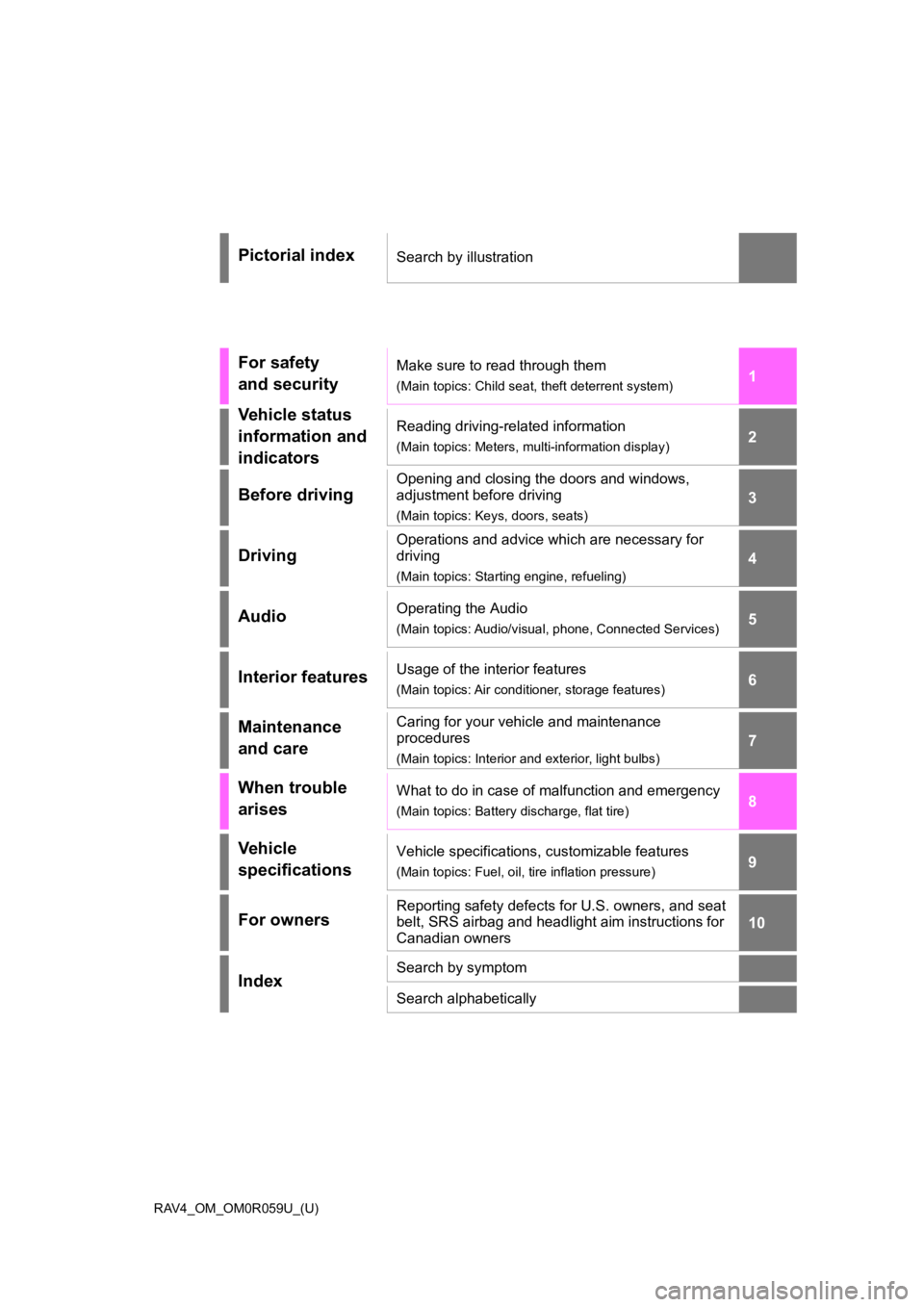
RAV4_OM_OM0R059U_(U)
1
2
3
4
5
6
7
8
9
10
Pictorial indexSearch by illustration
For safety
and securityMake sure to read through them
(Main topics: Child seat, theft deterrent system)
Vehicle status
information and
indicatorsReading driving-related information
(Main topics: Meters, multi-information display)
Before driving
Opening and closing the doors and windows,
adjustment before driving
(Main topics: Keys, doors, seats)
Driving
Operations and advice which are necessary for
driving
(Main topics: Starting engine, refueling)
AudioOperating the Audio
(Main topics: Audio/visual, phone, Connected Services)
Interior featuresUsage of the interior features
(Main topics: Air conditioner, storage features)
Maintenance
and careCaring for your vehicle and maintenance
procedures
(Main topics: Interior and exterior, light bulbs)
When trouble
arisesWhat to do in case of malfunction and emergency
(Main topics: Battery discharge, flat tire)
Vehicle
specificationsVehicle specifications, customizable features
(Main topics: Fuel, oil, tire inflation pressure)
For ownersReporting safety defects for U.S. owners, and seat
belt, SRS airbag and headlight aim instructions for
Canadian owners
IndexSearch by symptom
Search alphabetically
Page 5 of 748
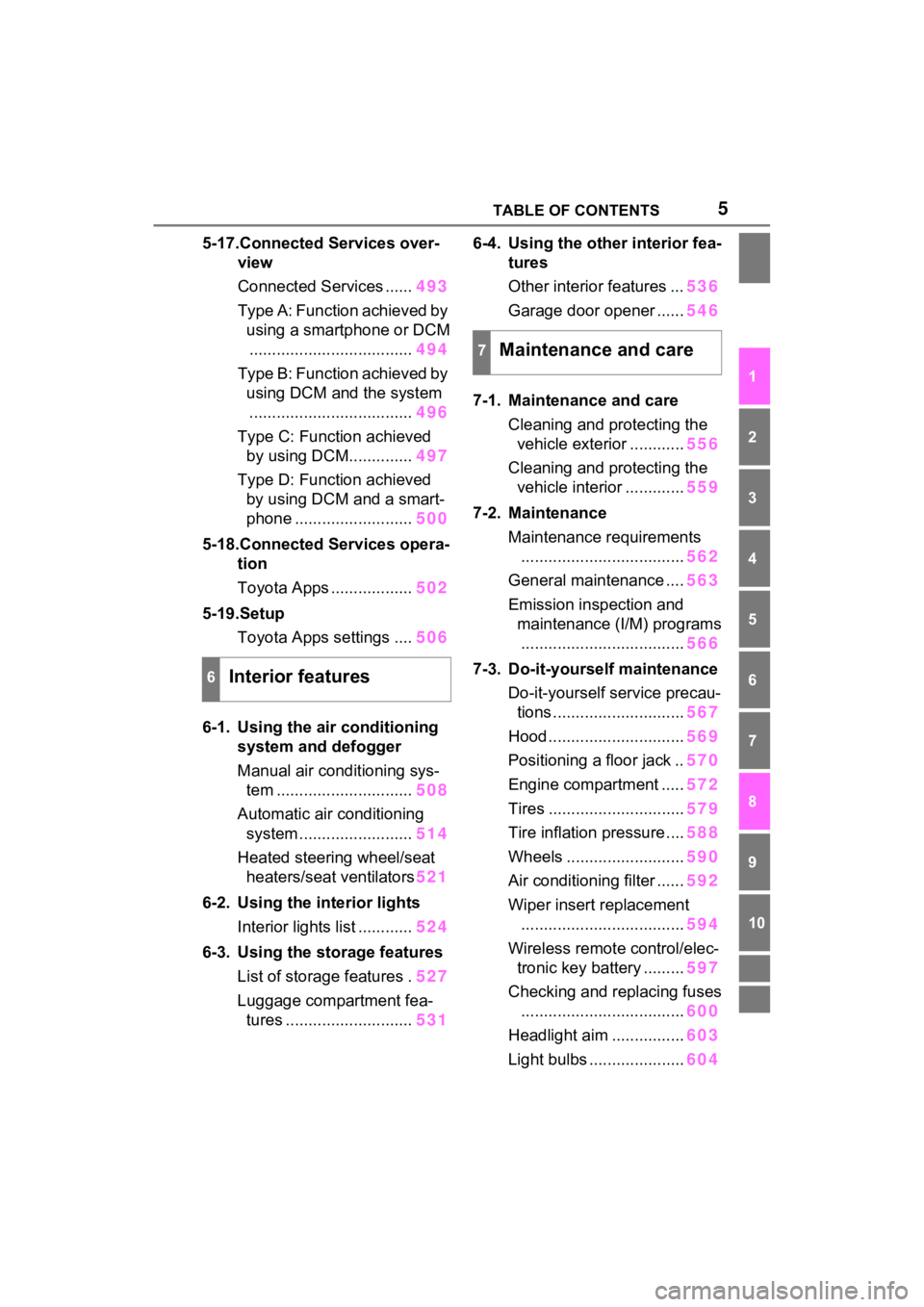
5TABLE OF CONTENTS
1
2
3
4
5
6
7
8
9
10
5-17.Connected Services over-view
Connected Services ...... 493
Type A: Function achieved by using a smartphone or DCM.................................... 494
Type B: Function achieved by using DCM and the system
.................................... 496
Type C: Function achieved by using DCM.............. 497
Type D: Function achieved by using DCM and a smart-
phone .......................... 500
5-18.Connected Services opera- tion
Toyota Apps .................. 502
5-19.Setup Toyota Apps settings .... 506
6-1. Using the air conditioning
system and defogger
Manual air conditioning sys- tem .............................. 508
Automatic air conditioning system ......................... 514
Heated steering wheel/seat heaters/seat ventilators 521
6-2. Using the interior lights Interior lights list ............ 524
6-3. Using the storage features List of storage features . 527
Luggage compartment fea- tures ............................ 5316-4. Using the other interior fea-
tures
Other interior features ... 536
Garage door opener ...... 546
7-1. Maintenance and care Cleaning and protecting the vehicle exterior ............ 556
Cleaning and protecting the vehicle interior ............. 559
7-2. Maintenance Maintenance requirements.................................... 562
General maintenance .... 563
Emission inspection and maintenance (I/M) programs.................................... 566
7-3. Do-it-yourself maintenance Do-it-yourself service precau-tions ............................. 567
Hood .............................. 569
Positioning a floor jack .. 570
Engine compartment ..... 572
Tires .............................. 579
Tire inflation pressure .... 588
Wheels .......................... 590
Air conditioning filter ...... 592
Wiper insert replacement .................................... 594
Wireless remote control/elec- tronic key battery ......... 597
Checking and replacing fuses .................................... 600
Headlight aim ................ 603
Light bulbs ..................... 604
6Interior features
7Maintenance and care
Page 6 of 748
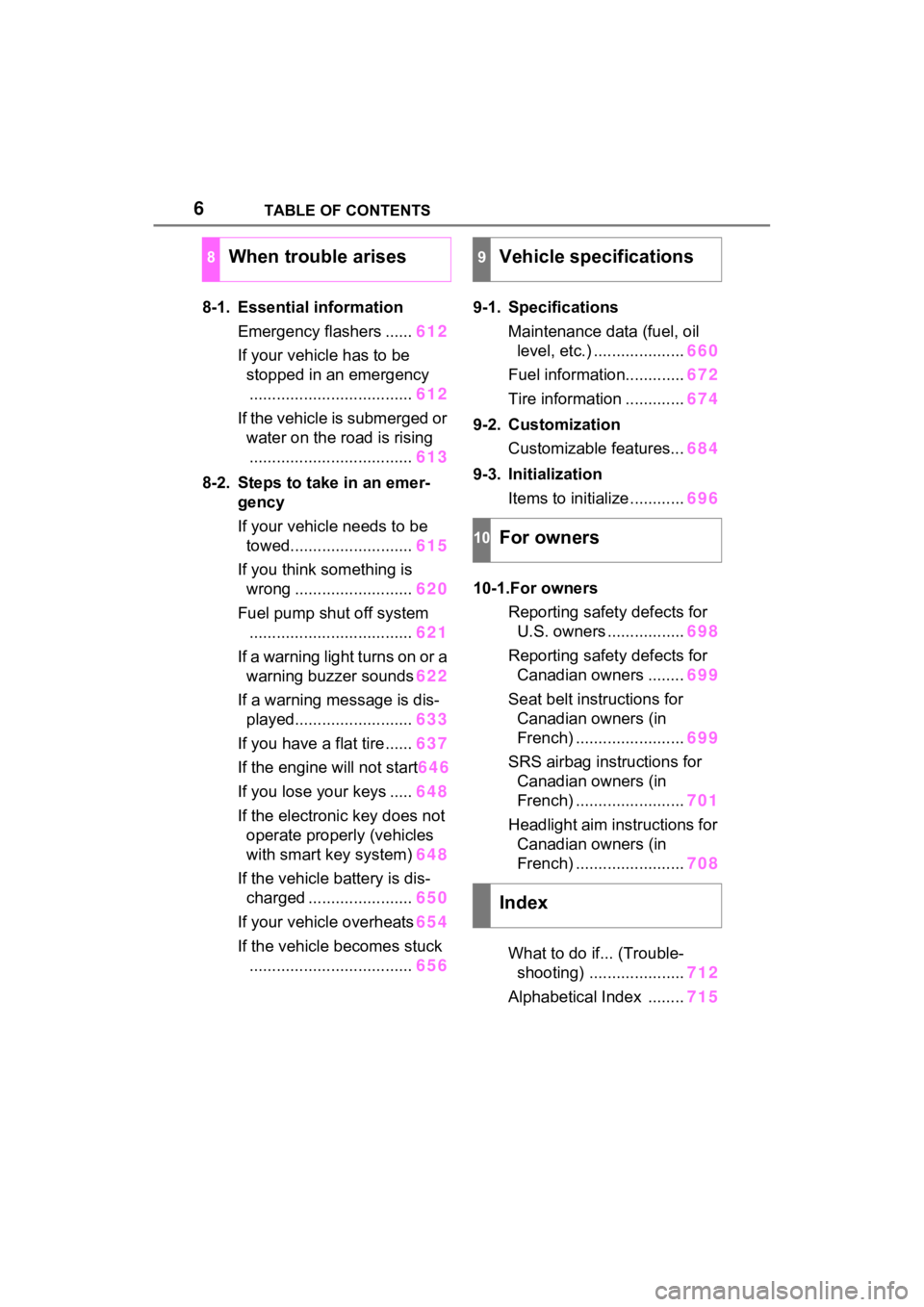
6TABLE OF CONTENTS
8-1. Essential informationEmergency flashers ...... 612
If your vehicle has to be stopped in an emergency.................................... 612
If the vehicle is submerged or water on the road is rising.................................... 613
8-2. Steps to take in an emer- gency
If your vehicle needs to be towed........................... 615
If you think something is wrong .......................... 620
Fuel pump shut off system .................................... 621
If a warning light turns on or a warning buzzer sounds 622
If a warning message is dis- played.......................... 633
If you have a flat tire...... 637
If the engine will not start 646
If you lose your keys ..... 648
If the electronic key does not operate properly (vehicles
with smart key system) 648
If the vehicle battery is dis- charged ....................... 650
If your vehicle overheats 654
If the vehicle becomes stuck .................................... 6569-1. Specifications
Maintenance data (fuel, oil level, etc.) .................... 660
Fuel information............. 672
Tire information ............. 674
9-2. Customization Customizable features... 684
9-3. Initialization Items to initialize ............ 696
10-1.For owners Reporting safet y defects for
U.S. owners ................. 698
Reporting safet y defects for
Canadian owners ........ 699
Seat belt instructions for Canadian owners (in
French) ........................ 699
SRS airbag instructions for Canadian owners (in
French) ........................ 701
Headlight aim instructions for Canadian owners (in
French) ........................ 708
What to do if... (Trouble- shooting) ..................... 712
Alphabetical Index ........ 715
8When trouble arises9Vehicle specifications
10For owners
Index
Page 17 of 748
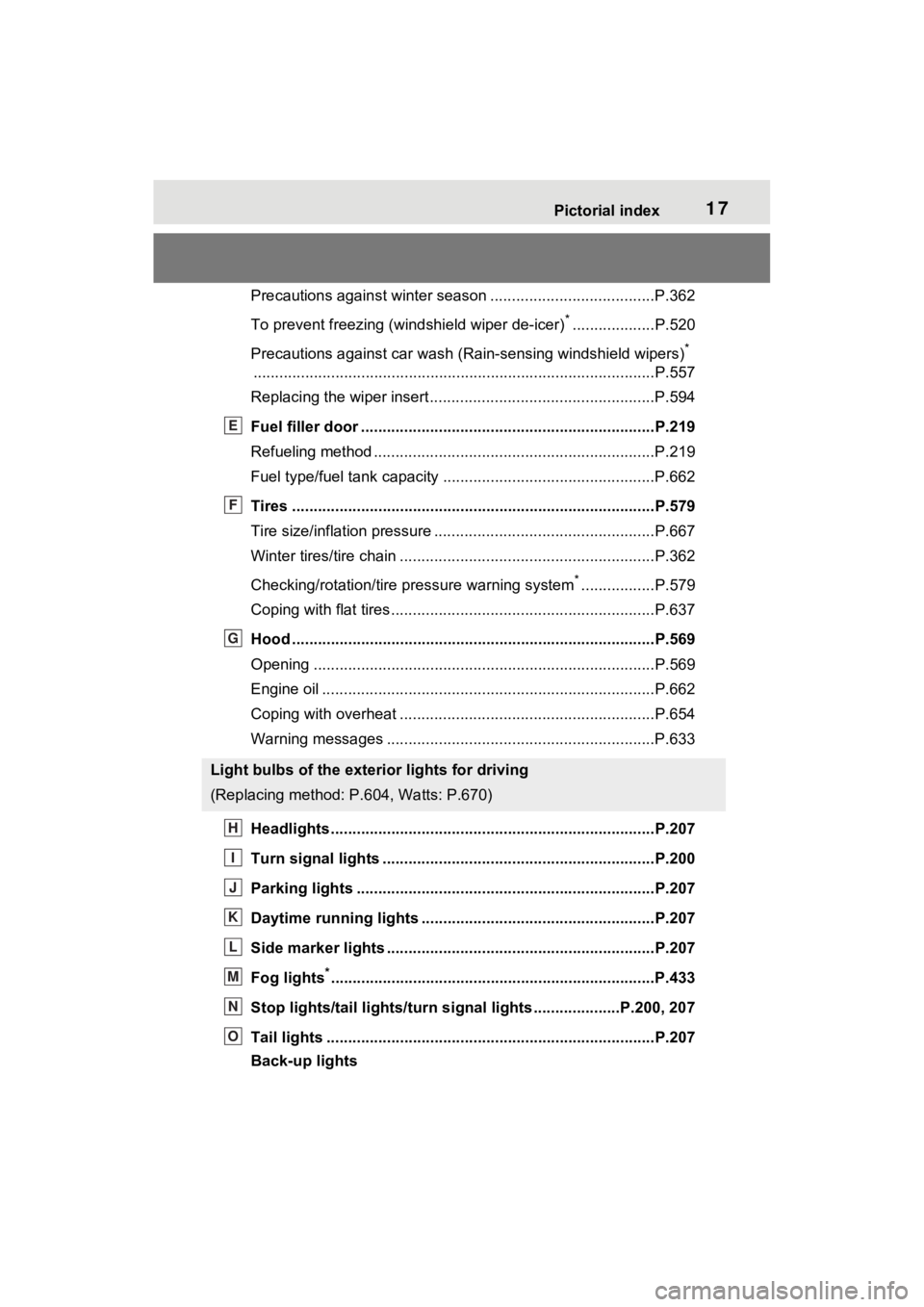
17Pictorial index
Precautions against winter season ......................................P.362
To prevent freezing (windshield wiper de-icer)
*...................P.520
Precautions against car wash (R ain-sensing windshield wipers)
*
............................................................... ..............................P.557
Replacing the wiper insert ..................................... ...............P.594
Fuel filler door ............................................... .....................P.219
Refueling method ............................................... ..................P.219
Fuel type/fuel tan k capacity .................................................P.662
Tires ....................................................................................P.579
Tire size/inflation pressure ................................... ................P.667
Winter tires/tire chain ........................................ ...................P.362
Checking/rotation/tire pressure warning system
*.................P.579
Coping with flat tires......................................... ....................P.637
Hood ....................................................................................P.569
Opening ........................................................ .......................P.569
Engine oil ..................................................... ........................P.662
Coping with overheat ........................................... ................P.654
Warning messages ..............................................................P.633
Headlights..................................................... ......................P.207
Turn signal lights ...............................................................P.200
Parking lights .....................................................................P.207
Daytime running lights .. ....................................................P.207
Side marker lights ............................................. .................P.207
Fog lights
*............................................................... ............P.433
Stop lights/tail lights/turn s ignal lights ....................P.200, 207
Tail lights .................................................... ........................P.207
Back-up lights
Light bulbs of the exterior lights for driving
(Replacing method: P .604, Watts: P.670)
E
F
G
H
I
J
K
L
M
N
O
Page 70 of 748
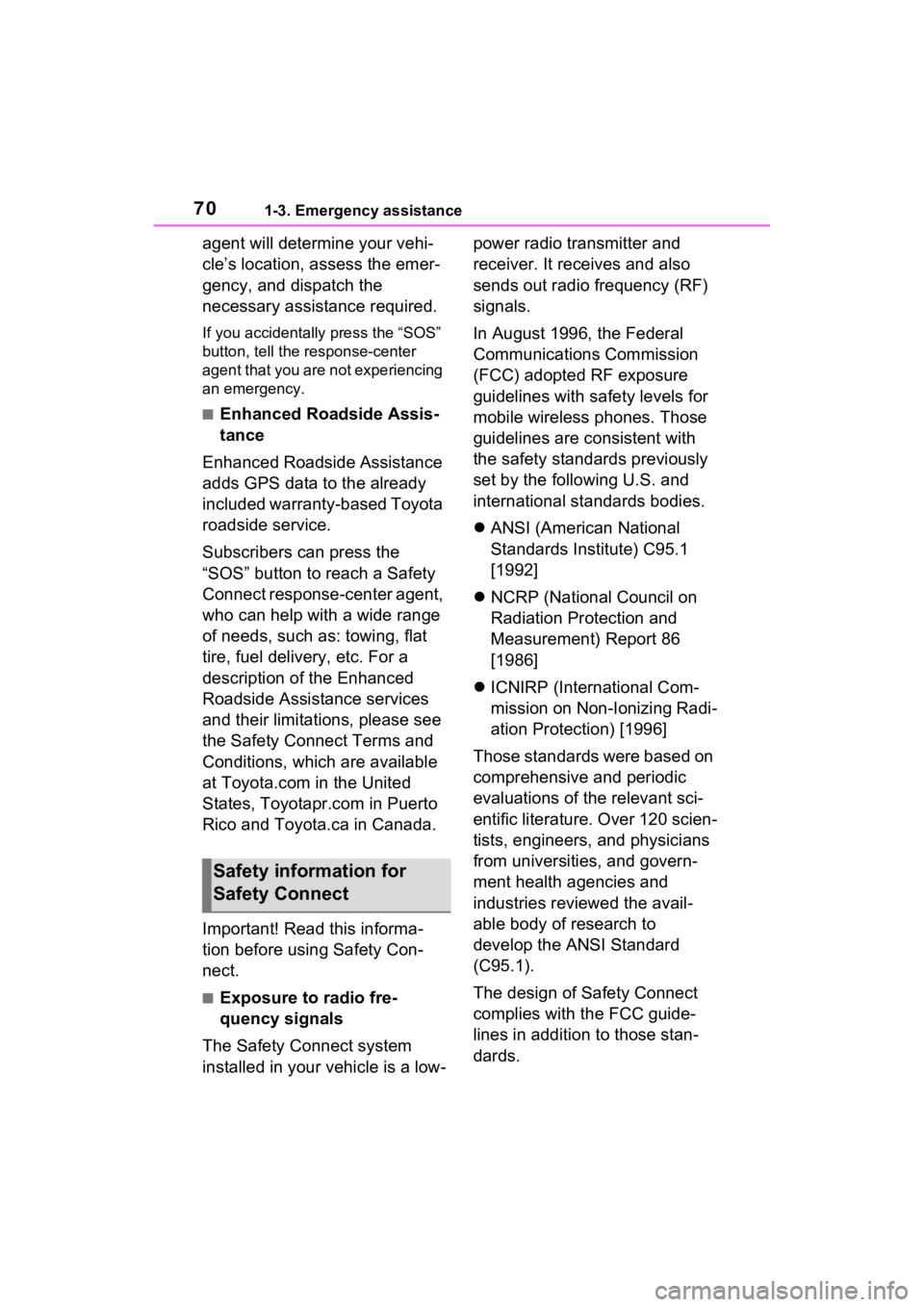
701-3. Emergency assistance
agent will determine your vehi-
cleŌĆÖs location, assess the emer-
gency, and dispatch the
necessary assistance required.
If you accidentally press the ŌĆ£SOSŌĆØ
button, tell the response-center
agent that you are not experiencing
an emergency.
Ō¢ĀEnhanced Roadside Assis-
tance
Enhanced Roadside Assistance
adds GPS data to the already
included warranty-based Toyota
roadside service.
Subscribers can press the
ŌĆ£SOSŌĆØ button to reach a Safety
Connect response-center agent,
who can help with a wide range
of needs, such as: towing, flat
tire, fuel delivery, etc. For a
description of the Enhanced
Roadside Assistance services
and their limitations, please see
the Safety Connect Terms and
Conditions, which are available
at Toyota.com in the United
States, Toyotapr.com in Puerto
Rico and Toyota.ca in Canada.
Important! Read this informa-
tion before using Safety Con-
nect.
Ō¢ĀExposure to radio fre-
quency signals
The Safety Connect system
installed in your vehicle is a low- power radio transmitter and
receiver. It receives and also
sends out radio frequency (RF)
signals.
In August 1996, the Federal
Communications Commission
(FCC) adopted RF exposure
guidelines with safety levels for
mobile wireless phones. Those
guidelines are consistent with
the safety standards previously
set by the following U.S. and
international standards bodies.
’ü¼
ANSI (American National
Standards Institute) C95.1
[1992]
’ü¼ NCRP (National Council on
Radiation Protection and
Measurement) Report 86
[1986]
’ü¼ ICNIRP (International Com-
mission on Non-Ionizing Radi-
ation Protection) [1996]
Those standards were based on
comprehensive and periodic
evaluations of the relevant sci-
entific literature. Over 120 scien-
tists, engineers, and physicians
from universities, and govern-
ment health agencies and
industries reviewed the avail-
able body of research to
develop the ANSI Standard
(C95.1).
The design of Safety Connect
complies with the FCC guide-
lines in addition to those stan-
dards.
Safety information for
Safety Connect
Page 172 of 748
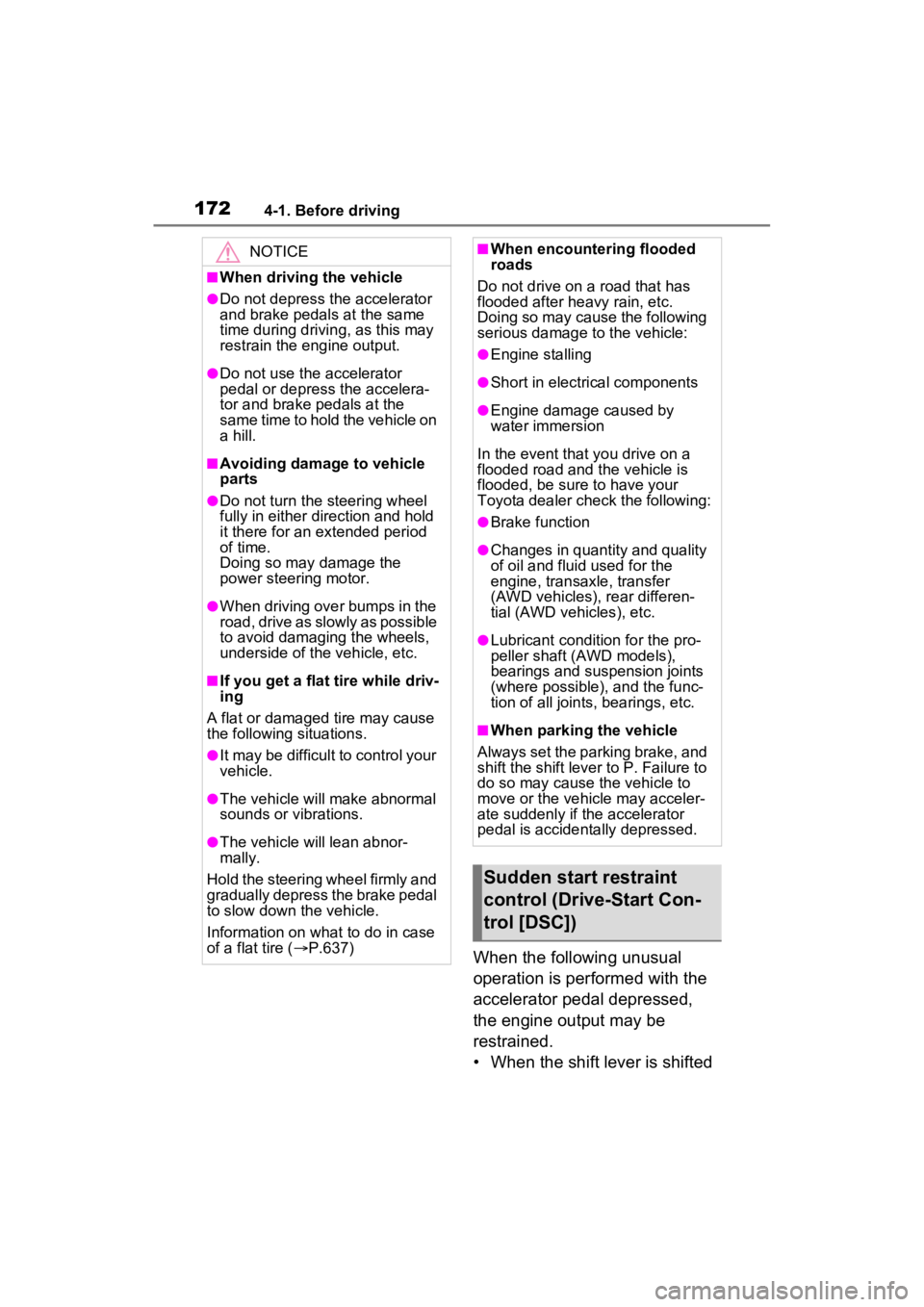
1724-1. Before driving
When the following unusual
operation is performed with the
accelerator pedal depressed,
the engine output may be
restrained.
ŌĆó When the shift lever is shifted
NOTICE
Ō¢ĀWhen driving the vehicle
ŌŚÅDo not depress t he accelerator
and brake pedals at the same
time during drivin g, as this may
restrain the engine output.
ŌŚÅDo not use the accelerator
pedal or depress the accelera-
tor and brake pedals at the
same time to hold the vehicle on
a hill.
Ō¢ĀAvoiding damage to vehicle
parts
ŌŚÅDo not turn the steering wheel
fully in either direction and hold
it there for an extended period
of time.
Doing so may damage the
power steering motor.
ŌŚÅWhen driving over bumps in the
road, drive as slowly as possible
to avoid damagi ng the wheels,
underside of the vehicle, etc.
Ō¢ĀIf you get a flat tire while driv-
ing
A flat or damaged tire may cause
the following situations.
ŌŚÅIt may be difficult to control your
vehicle.
ŌŚÅThe vehicle will make abnormal
sounds or vibrations.
ŌŚÅThe vehicle will lean abnor-
mally.
Hold the steering wheel firmly and
gradually depress the brake pedal
to slow down the vehicle.
Information on what to do in case
of a flat tire ( ’é«P.637)
Ō¢ĀWhen encountering flooded
roads
Do not drive on a road that has
flooded after heavy rain, etc.
Doing so may cause the following
serious damage to the vehicle:
ŌŚÅEngine stalling
ŌŚÅShort in electrical components
ŌŚÅEngine damage caused by
water immersion
In the event that you drive on a
flooded road and the vehicle is
flooded, be sure to have your
Toyota dealer check the following:
ŌŚÅBrake function
ŌŚÅChanges in quantity and quality
of oil and fluid used for the
engine, transaxle, transfer
(AWD vehicles), rear differen-
tial (AWD vehicles), etc.
ŌŚÅLubricant condition for the pro-
peller shaft (AWD models),
bearings and suspension joints
(where possible), and the func-
tion of all joints, bearings, etc.
Ō¢ĀWhen parking the vehicle
Always set the parking brake, and
shift the shift lever to P. Failure to
do so may cause the vehicle to
move or the vehicle may acceler-
ate suddenly if t he accelerator
pedal is accidentally depressed.
Sudden start restraint
control (Drive-Start Con-
trol [DSC])
Page 178 of 748
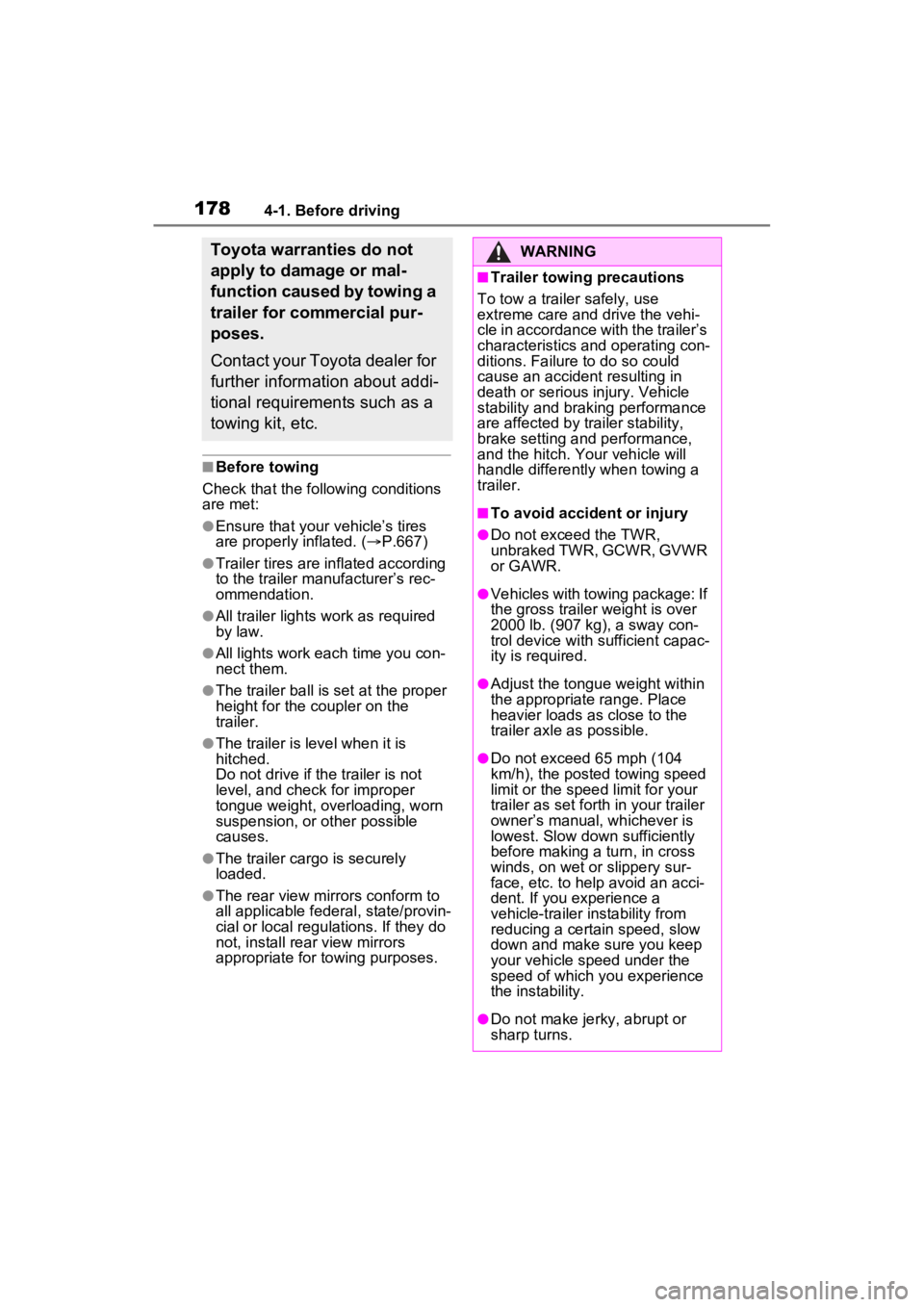
1784-1. Before driving
Ō¢ĀBefore towing
Check that the following conditions
are met:
ŌŚÅEnsure that your vehicleŌĆÖs tires
are properly inflated. (’é« P.667)
ŌŚÅTrailer tires are inflated according
to the trailer manufacturerŌĆÖs rec-
ommendation.
ŌŚÅAll trailer lights work as required
by law.
ŌŚÅAll lights work each time you con-
nect them.
ŌŚÅThe trailer ball is set at the proper
height for the coupler on the
trailer.
ŌŚÅThe trailer is level when it is
hitched.
Do not drive if the trailer is not
level, and check for improper
tongue weight, overloading, worn
suspension, or other possible
causes.
ŌŚÅThe trailer cargo is securely
loaded.
ŌŚÅThe rear view mirrors conform to
all applicable federal, state/provin-
cial or local regu lations. If they do
not, install rear view mirrors
appropriate for towing purposes.
Toyota warranties do not
apply to damage or mal-
function caused by towing a
trailer for commercial pur-
poses.
Contact your Toyota dealer for
further information about addi-
tional requirements such as a
towing kit, etc.WARNING
Ō¢ĀTrailer towing precautions
To tow a trailer safely, use
extreme care and drive the vehi-
cle in accordance with the trailerŌĆÖs
characteristics and operating con-
ditions. Failure to do so could
cause an accident resulting in
death or serious injury. Vehicle
stability and brak ing performance
are affected by trailer stability,
brake setting and performance,
and the hitch. Yo ur vehicle will
handle differently when towing a
trailer.
Ō¢ĀTo avoid accident or injury
ŌŚÅDo not exceed the TWR,
unbraked TWR, GCWR, GVWR
or GAWR.
ŌŚÅVehicles with towing package: If
the gross trailer weight is over
2000 lb. (907 kg), a sway con-
trol device with sufficient capac-
ity is required.
ŌŚÅAdjust the tongue weight within
the appropriate range. Place
heavier loads as close to the
trailer axle as possible.
ŌŚÅDo not exceed 65 mph (104
km/h), the posted towing speed
limit or the spee d limit for your
trailer as set forth in your trailer
ownerŌĆÖs manual, whichever is
lowest. Slow down sufficiently
before making a turn, in cross
winds, on wet or slippery sur-
face, etc. to help avoid an acci-
dent. If you experience a
vehicle-trailer instability from
reducing a certain speed, slow
down and make sure you keep
your vehicle speed under the
speed of which you experience
the instability.
ŌŚÅDo not make jer ky, abrupt or
sharp turns.
Page 186 of 748
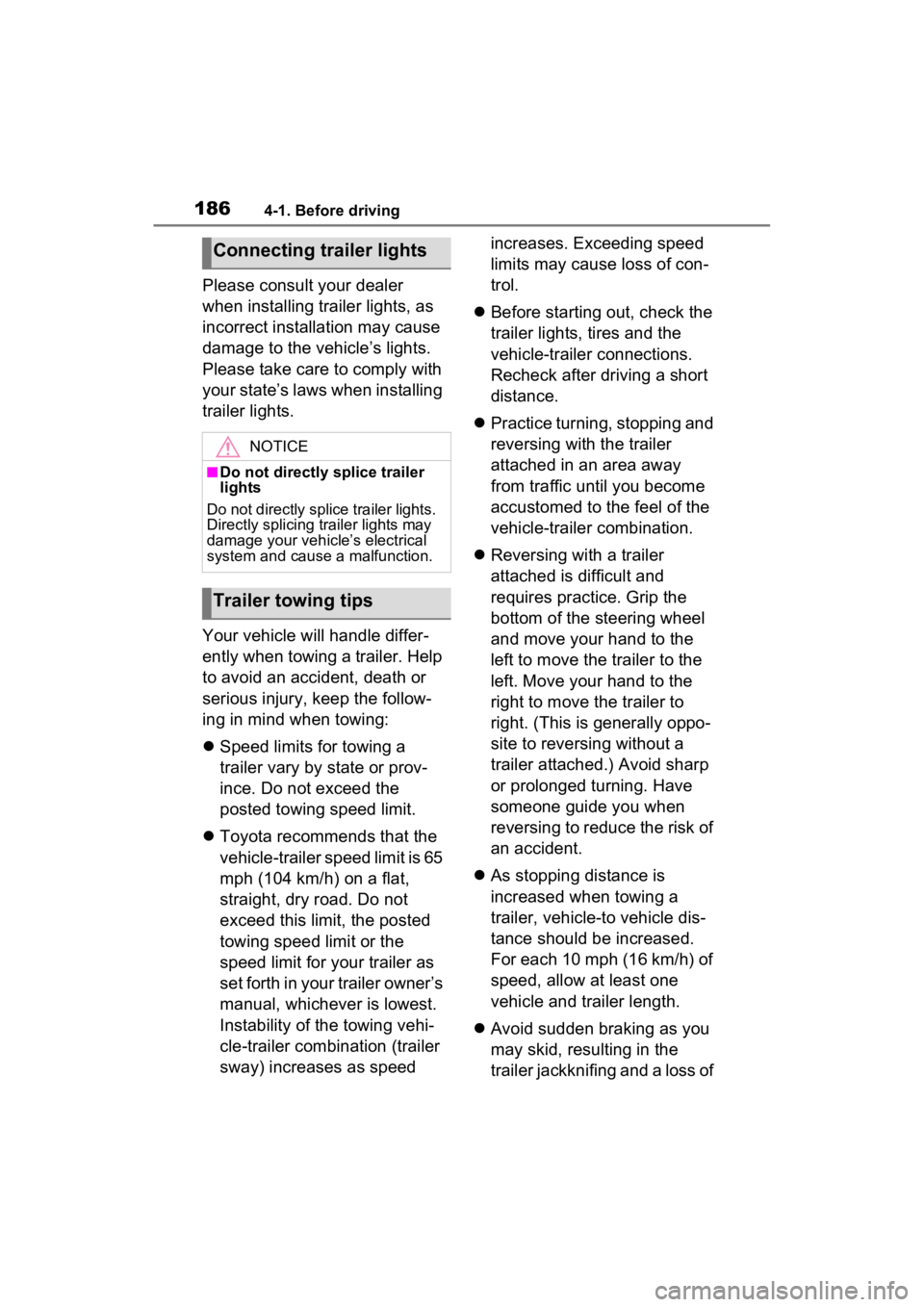
1864-1. Before driving
Please consult your dealer
when installing trailer lights, as
incorrect installation may cause
damage to the vehicleŌĆÖs lights.
Please take care to comply with
your stateŌĆÖs laws when installing
trailer lights.
Your vehicle will handle differ-
ently when towing a trailer. Help
to avoid an accident, death or
serious injury, keep the follow-
ing in mind when towing:
’ü¼Speed limits for towing a
trailer vary by state or prov-
ince. Do not exceed the
posted towing speed limit.
’ü¼ Toyota recommends that the
vehicle-trailer speed limit is 65
mph (104 km/h) on a flat,
straight, dry road. Do not
exceed this limit, the posted
towing speed limit or the
speed limit for your trailer as
set forth in your trailer ownerŌĆÖs
manual, whichever is lowest.
Instability of the towing vehi-
cle-trailer combination (trailer
sway) increases as speed increases. Exceeding speed
limits may cause loss of con-
trol.
’ü¼ Before starting out, check the
trailer lights, tires and the
vehicle-trailer connections.
Recheck after driving a short
distance.
’ü¼ Practice turning, stopping and
reversing with the trailer
attached in an area away
from traffic until you become
accustomed to the feel of the
vehicle-trailer combination.
’ü¼ Reversing with a trailer
attached is difficult and
requires practice. Grip the
bottom of the steering wheel
and move your hand to the
left to move the trailer to the
left. Move your hand to the
right to move the trailer to
right. (This is generally oppo-
site to reversing without a
trailer attached.) Avoid sharp
or prolonged turning. Have
someone guide you when
reversing to reduce the risk of
an accident.
’ü¼ As stopping distance is
increased when towing a
trailer, vehicle-to vehicle dis-
tance should be increased.
For each 10 mph (16 km/h) of
speed, allow at least one
vehicle and trailer length.
’ü¼ Avoid sudden braking as you
may skid, resulting in the
trailer jackknifing and a loss of
Connecting trailer lights
NOTICE
Ō¢ĀDo not directly splice trailer
lights
Do not directly splice trailer lights.
Directly splicing trailer lights may
damage your vehicleŌĆÖs electrical
system and cause a malfunction.
Trailer towing tips
Page 212 of 748
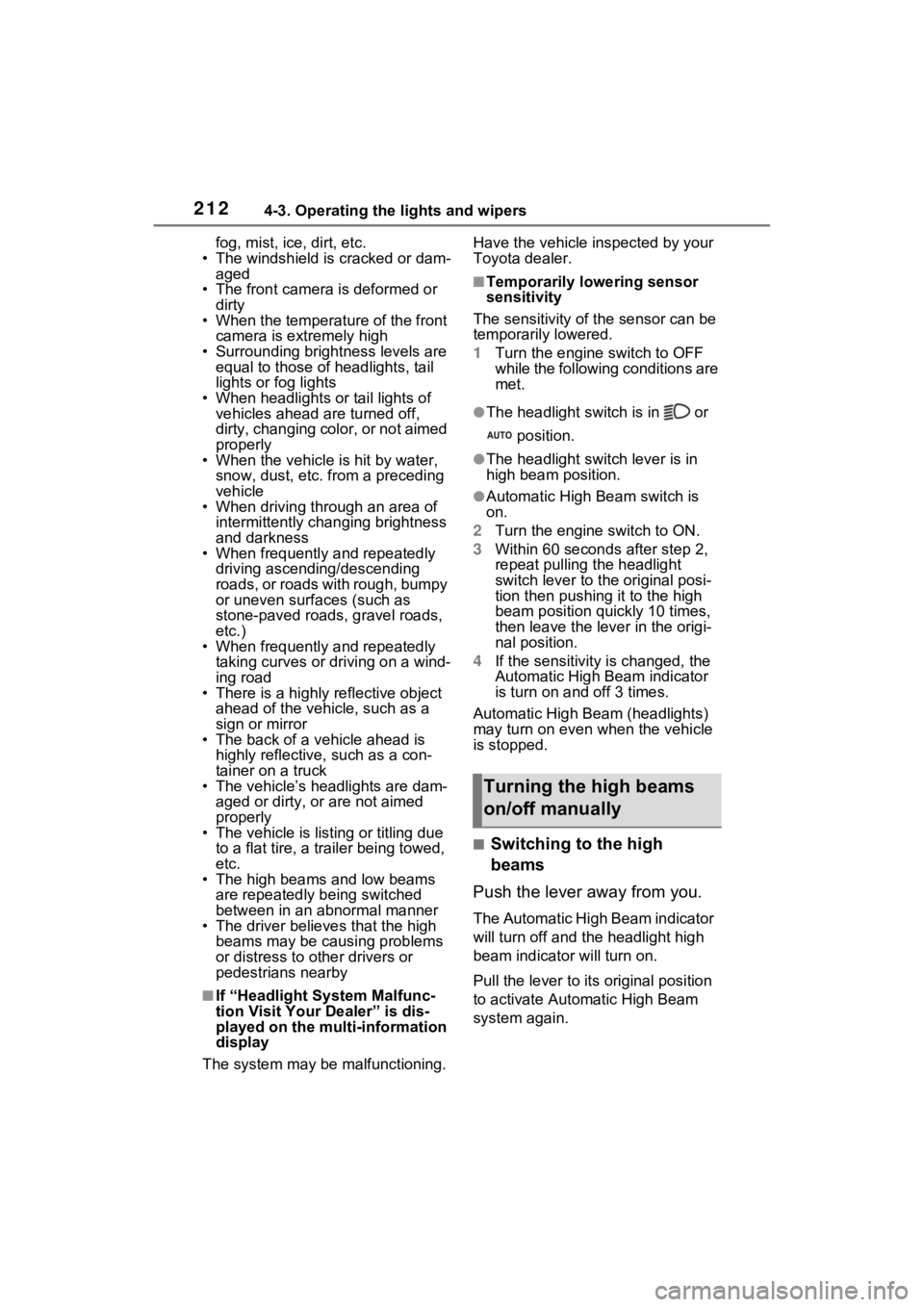
2124-3. Operating the lights and wipers
fog, mist, ice, dirt, etc.
ŌĆó The windshield is cracked or dam- aged
ŌĆó The front camera is deformed or
dirty
ŌĆó When the temperature of the front
camera is extremely high
ŌĆó Surrounding brightness levels are equal to those of h eadlights, tail
lights or fog lights
ŌĆó When headlights or tail lights of vehicles ahead are turned off,
dirty, changing color, or not aimed
properly
ŌĆó When the vehicle is hit by water,
snow, dust, etc. fr om a preceding
vehicle
ŌĆó When driving thr ough an area of
intermittently changing brightness
and darkness
ŌĆó When frequently and repeatedly
driving ascending/descending
roads, or roads with rough, bumpy
or uneven surfaces (such as
stone-paved roads, gravel roads,
etc.)
ŌĆó When frequently and repeatedly
taking curves or driving on a wind-
ing road
ŌĆó There is a highly reflective object
ahead of the vehicle, such as a
sign or mirror
ŌĆó The back of a vehicle ahead is
highly reflective, such as a con-
tainer on a truck
ŌĆó The vehicleŌĆÖs headlights are dam-
aged or dirty, or are not aimed
properly
ŌĆó The vehicle is listing or titling due
to a flat tire, a trailer being towed,
etc.
ŌĆó The high beams and low beams
are repeatedly being switched
between in an abnormal manner
ŌĆó The driver believes that the high
beams may be causing problems
or distress to other drivers or
pedestrians nearby
Ō¢ĀIf ŌĆ£Headlight System Malfunc-
tion Visit Your D ealerŌĆØ is dis-
played on the multi-information
display
The system may be malfunctioning. Have the vehicle inspected by your
Toyota dealer.
Ō¢ĀTemporarily lowering sensor
sensitivity
The sensitivity of the sensor can be
temporarily lowered.
1 Turn the engine switch to OFF
while the following conditions are
met.
ŌŚÅThe headlight switch is in or
position.
ŌŚÅThe headlight switch lever is in
high beam position.
ŌŚÅAutomatic High Beam switch is
on.
2 Turn the engine switch to ON.
3 Within 60 second s after step 2,
repeat pulling the headlight
switch lever to the original posi-
tion then pushing it to the high
beam position qui ckly 10 times,
then leave the lever in the origi-
nal position.
4 If the sensitivity is changed, the
Automatic High Beam indicator
is turn on and off 3 times.
Automatic High Beam (headlights)
may turn on even when the vehicle
is stopped.
Ō¢ĀSwitching to the high
beams
Push the lever away from you.
The Automatic High Beam indicator
will turn off and the headlight high
beam indicator will turn on.
Pull the lever to its original position
to activate Automatic High Beam
system again.
Turning the high beams
on/off manually
Page 229 of 748
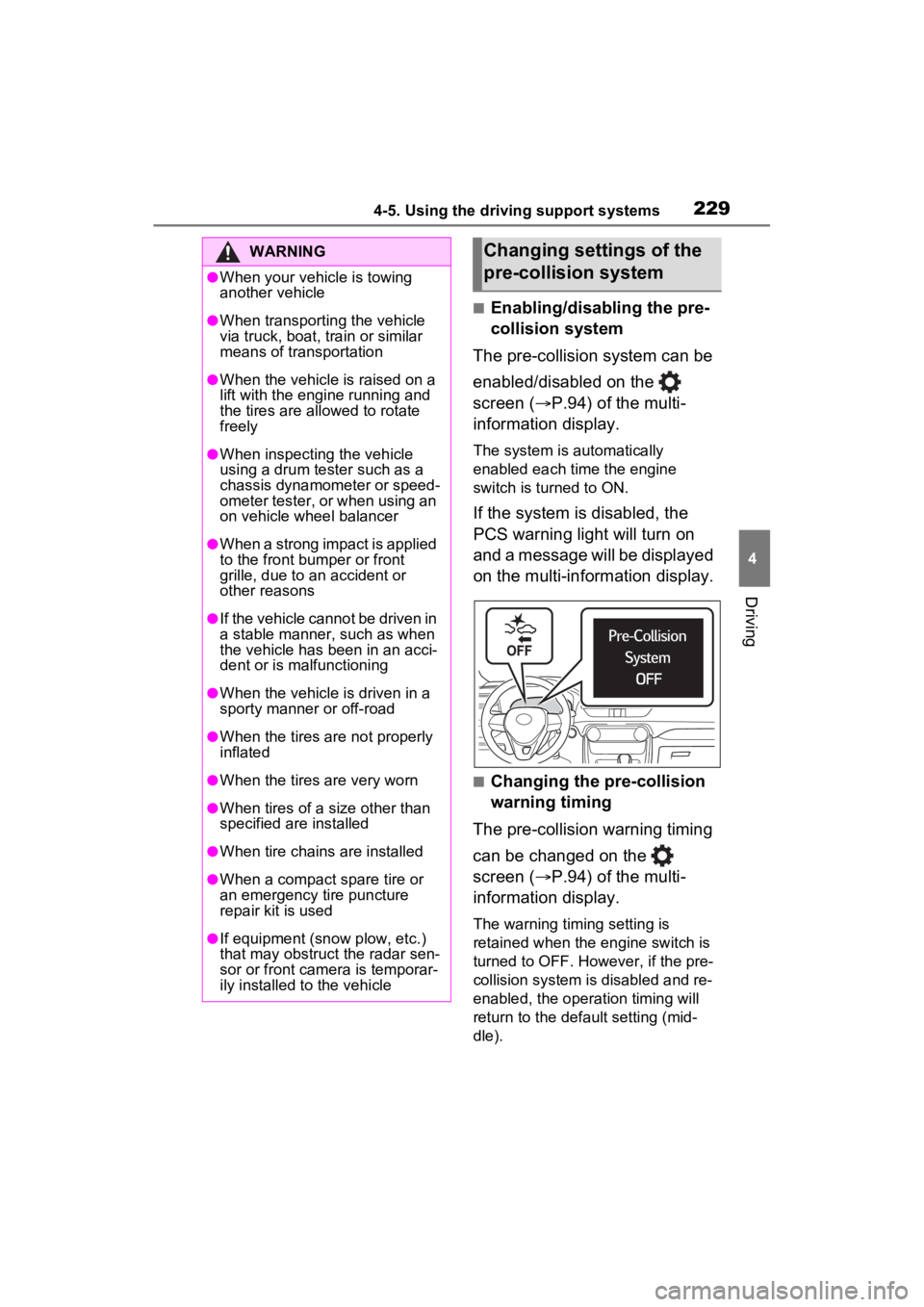
2294-5. Using the driving support systems
4
Driving
Ō¢ĀEnabling/disabling the pre-
collision system
The pre-collision system can be
enabled/disabled on the
screen ( ’é«P.94) of the multi-
information display.
The system is automatically
enabled each time the engine
switch is turned to ON.
If the system is disabled, the
PCS warning light will turn on
and a message will be displayed
on the multi-information display.
Ō¢ĀChanging the pre-collision
warning timing
The pre-collision warning timing
can be changed on the
screen ( ’é«P.94) of the multi-
information display.
The warning timing setting is
retained when the engine switch is
turned to OFF. However, if the pre-
collision system is disabled and re-
enabled, the operation timing will
return to the default setting (mid-
dle).
WARNING
ŌŚÅWhen your vehicle is towing
another vehicle
ŌŚÅWhen transporting the vehicle
via truck, boat, train or similar
means of transportation
ŌŚÅWhen the vehicle is raised on a
lift with the engine running and
the tires are allowed to rotate
freely
ŌŚÅWhen inspecting the vehicle
using a drum tester such as a
chassis dynamometer or speed-
ometer tester, or when using an
on vehicle wheel balancer
ŌŚÅWhen a strong impact is applied
to the front bumper or front
grille, due to a n accident or
other reasons
ŌŚÅIf the vehicle cannot be driven in
a stable manner, such as when
the vehicle has been in an acci-
dent or is malfunctioning
ŌŚÅWhen the vehicle is driven in a
sporty manner or off-road
ŌŚÅWhen the tires are not properly
inflated
ŌŚÅWhen the tires are very worn
ŌŚÅWhen tires of a size other than
specified are installed
ŌŚÅWhen tire chains are installed
ŌŚÅWhen a compact spare tire or
an emergency tire puncture
repair kit is used
ŌŚÅIf equipment (snow plow, etc.)
that may obstruct the radar sen-
sor or front camera is temporar-
ily installed to the vehicle
Changing settings of the
pre-collision system